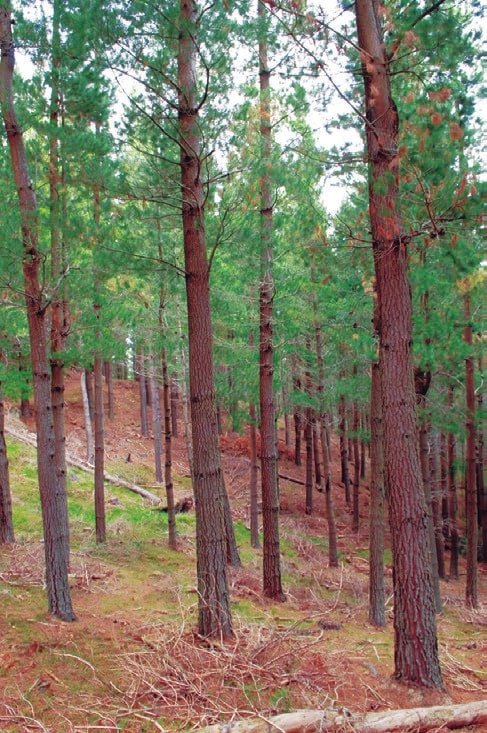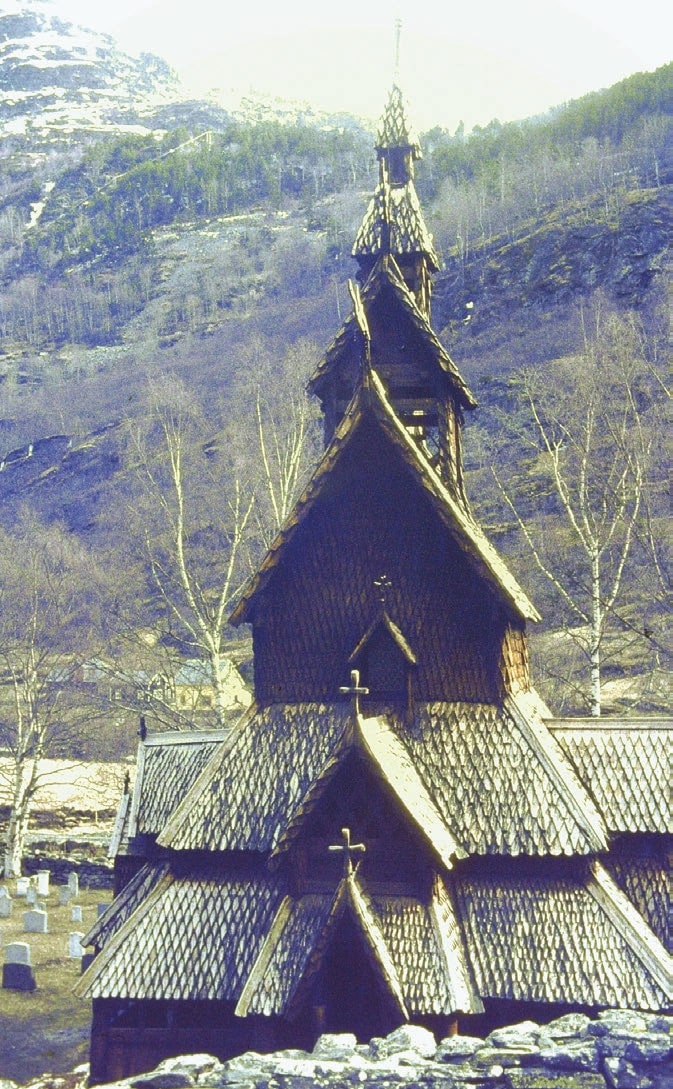Do we want carbon credits from harvested wood products?
Howard Moore, New Zealand Tree Grower May 2016.
Those of you who have stumbled across Lærdal in Norway, as you do, might have looked in some wonder at the Borgund stave church. It is a startling building, especially if you have not been smoking anything and you are not expecting to find it. As well as being a tense and spiky mix of Christian and Norse gods vying for architectural dominance, it is built of timber and has been standing there for 800 years. In almost any other country it would have been sacked by the Vikings years ago.
Harvested wood products
We all know examples of ancient timber structures, and so it is not surprising that it is an obvious idea to store carbon in wood. The idea has been formally accepted by the UN Framework Convention on Climate Change in accounting for harvested wood products − introducing HWP as a new acronym.
In New Zealand, because of the age class mix of forests planted since 1989, the government has adopted harvested wood product (HWP) accounting to help spread forward its international carbon obligations. If it was to ‘instantly oxidise’ all of our post-1989 trees as they were cut, the government would face a rather expensive bill. Now it will not.
The Forestry Technical Note released early in March for the current Emissions Trading Scheme review explains this, and notes that ‘The closer the settings in the NZ ETS align with [HWP methodology] the more easily the NZ ETS can be used to manage the Crown’s financial risk.’ In other words, because the Crown has HWP accounting, it wants us to have it as well.
Is that good or bad? Well, it is like being offered a sharp knife. It is useful, but if you pick it up by the wrong end it will bite you.


The risks of HWP
The risks arise because of the complexity in monitoring and accounting for the uses of wood and their decay rates. HWP accounting suggests that averaged nationally, New Zealand logs harvested and sold locally or to export, end up in products with the half-lives or decay rates as shown in the table above.
Fuelwood is rated as ‘instant oxidation’ but the remaining 283 tonnes of carbon dioxide equivalent would be ‘oxidised’ in the future, and so accounted for as a deferred liability. The question becomes whether, and if so how, this 283 tonnes per hectare of carbon dioxide equivalent should be devolved to the industry. The risk of that becomes whether, and if so how much, the different carbon storage lives of HWP products would distort market prices.
Should processors be liable for stored carbon once the products are out of their control? How would you price woodchips when they might be used for fuel, pulp or panels? Would imported liner board need a duty to make it the same price as local liner board? Would growers demand higher log prices from local mills than from exporters? HWP accounting at anything less than a national level looks tricky. Picked up by the sharp end, this knife can do a lot of damage.
A meeting in Wellington on 4 February attended by forest growers, wood processors, economists and government officials looked at the suggestion. There was lukewarm encouragement by the officials but the rest of us backed away. Dazzled by the blade, we felt that the knife on offer looked too dangerous.
After the meeting some of us realised that we had ignored the handle of the knife. Could we pick up benefits from devolution without adopting HWP accounting? As it turns out the answer is yes. For growers this is relatively easy.
| Product | Product mix | Tonnes of carbon dioxide equivalent allocated per hectare | Half-life in years |
|---|---|---|---|
| Sawn timber | 31.5% | 141 | 35 |
| Panels | 11.6% | 52 | 25 |
| Pulp and paper | 20.2% | 90 | 2 |
| Fuelwood | 36.8% | 165 | 0 |
| Totals | 100% | 448 |
The benefits of HWP
Earlier I said the government would like to align the Emissions Trading Scheme with HWP accounting practices. These assume that the carbon stored in HWP is released according to an exponential decay curve like radioactivity.
For example, given the product half-lives in the table above, 20 years after harvest the deferred liability for carbon still in storage would have dropped from 283 tonnes per hectare of carbon dioxide equivalent to around 120 tonnes. These figures are the result of having ‘oxidised’ all of the pulp, half of the panels and a third of the timber. The sum is 90 + 26 + 47 = 163 tonnes, subtracted from 283 which gives 120 tonnes.
Instead of slavishly following the exponential decay curve, you could achieve a similar result by ‘oxidising’ 160 tonnes of carbon dioxide equivalent in a straight line over the same period. You could totally avoid HWP accounting by using a simple number and linear decay, while still giving reasonable alignment for the Crown in that a straight line approximates a shallow arc.
Harvest residues give us an easy way to do this. When harvesting a post-1989 radiata pine forest which has 800 tonnes of carbon dioxide equivalent per hectare, the present ETS lookup tables assume instant oxidation of all logs removed – 55 to 57 per cent of the sequestered carbon, or around 448 tonnes of carbon dioxide equivalent. Harvest residues left in the forest in the form of slash, stumps and roots, at around 352 tonnes of carbon dioxide equivalent, are assumed to oxidise in a straight line over the following 10 years.
In order to align with HWP accounting, we could simply add 160 tonnes of carbon dioxide equivalent to the harvest residues in the lookup tables and then ‘oxidise’ the total to zero in a straight line over 20 years. The harvest residues allowance would then reflect not only the wood left in the forest, but also much of that removed and converted to products.
The implications of devolving HWP
This simple change would have the following effects −
- For a post-1989 forest grower in the ETS who had claimed all of the credits available as the forest grew, the surrender liability on harvest would be reduced by 160 NZUs. That is worth having.
- The surrender liability of the deferred 160 NZUs would be fully covered by credits earned in the following rotation. In fact the annual surrender rate would fall from around 35 NZUs per hectare at present, or 352 NZUs over 10 years, to around 25 NZUs per hectare or 512 NZUs over 20 years.
As a result of the points outlined above the perceived risk of not being able to afford enough NZUs to meet the surrender liability would be reduced by over a third.
This is important if log prices are low and carbon prices are high. Consequently, forest owners would have a wider price window of log prices versus carbon prices in which it was profitable to harvest. Therefore −
- The average returns to forest owners would increase
- Investors would be encouraged to plant new forests
- There would be less risk of forests being held past maturity to avoid the costs of surrender.
As a result −
- Wood processors would have a more assured log supply as forests were planted, cut and replanted
- The risk of carbon loss from catastrophic storm events would be reduced as, on average, forests would be harvested more frequently.
Simply adding 160 NZUs to harvest residues provides reasonable alignment for the Crown without growers or processors having to take on the complexity of HWP accounting. The only reason to review the number of 160 NZUs in the future would be if the ETS was not producing the desired behaviour changes. Therefore −
- There would be no effect on log prices as the proposed change would not involve HWP accounting
- There would be no market distortion affecting wood processors. Domestic production, export production and wood product imports would all be treated equally without the need to account for carbon storage.
The change would not −
- Affect pre-1990 forest growers, as markets would not change
- Affect a post-1989 forest grower’s liability on deforestation because at that time all carbon liabilities in the grower’s ETS account would fall due as they do now
- Affect the government’s own HWP accounting practice or its reporting to the UNFCCC
- Lead to any additional compliance costs as MPI already has mechanisms for managing harvest residues in growers’ ETS accounts
- Appear to have any fiscal implications for the government, other than through the lag effect of growers deferring the surrender of 160 NZUs per hectare at harvest.
Behaviour change
The proposed change is simple, inexpensive and has implications that help with the basic purposes of the ETS which are to −
- Plant more forests on under-utilised or vulnerable land
- Improve returns and increase the wood processing sector with products that displace less benign competitors.
It appears to be a low-cost and low-risk way for the forestry sector to take advantage of the government’s offer to devolve the benefits of HWP accounting. At a carbon price of $10 for an NZU it would save $1,600 a hectare at harvest for a post-1989 forest grower in the ETS. With over 200,000 hectares of forests in the ETS, you do the sums.
Howard Moore is a member of the Wellington Branch of the NZFFA.

 Farm Forestry New Zealand
Farm Forestry New Zealand

